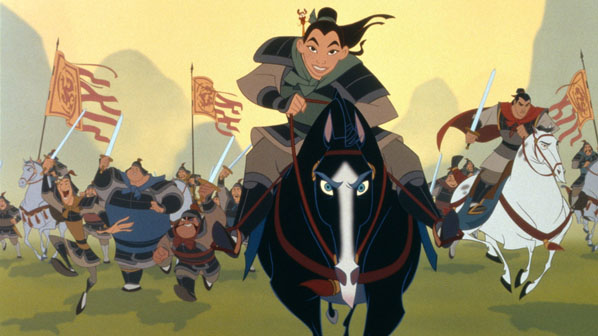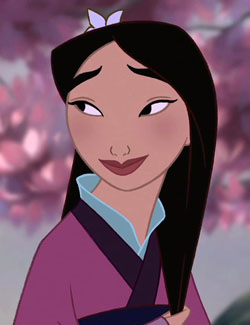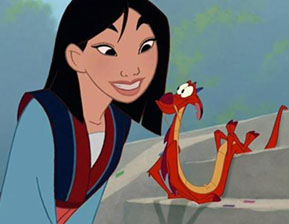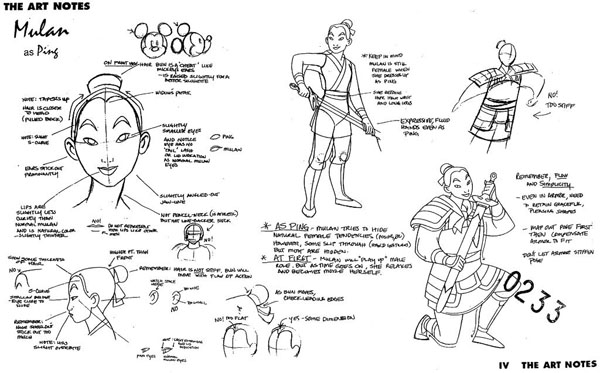
Disney’s 36th animated feature, Mulan, is based on a legendary Chinese folk tale that dates back to somewhere in the 4th century but still feels like a story for our times.
Just before the film’s release, Mulan’s producer Pam Coats noted that even though it is from a specific culture and a particular time, the messages are universal, like all great stories. “The overriding theme, as Shakespeare would put it is be true to yourself,” she said. “You succeed in life by figuring out who you are and being true to that and not being true to what someone expects from you or tells you to do.”
 This is just part of why, twenty-five years later, Mulan is still remembered as a watershed moment of Disney’s 1990s animation renaissance.
This is just part of why, twenty-five years later, Mulan is still remembered as a watershed moment of Disney’s 1990s animation renaissance.
Set 2,000 years ago in China, the film tells the tale of a young woman, Fa Mulan, who, to save and bring honor to her father and her family, dons the disguise of a Chinese soldier, and runs away to join the army, in answer to the Emperor’s draft notice.
Adopting the name “Ping,” she must convince the other soldiers that she is a man. This includes a group of rag-tag recruits, Chien-Po, Ling, and Yao, each with unique personality dysfunctions, as well as their leader, Captain Shang.
Guiding Mulan is the fast-talking “travel-sized” dragon, Mushu, assigned to her by her Ancestors, and Cri-Kee, the lucky cricket, bequeathed to her by her grandmother.
Mulan and the other soldiers are led into battle against the imposing villain, Shan-Yu, leader of the Huns, in some of the film’s impressive and epic sequences that showcase the distinctive look of Mulan.
“Poetic Simplicity” is how Thomas Schumacher, then Executive Vice President of Disney Feature Animation, described what the film should look like. “It describes what everybody wanted,” said the film’s production designer, Hans Bacher, in a 1998 interview. “We didn’t want to overload the backgrounds with too much information. We wanted to create a stage for the characters.”
 To bring this simple, uncluttered style to the screen, the Disney artists looked to Chinese art and the studio’s classic Bambi (1942). “The style of Bambi was developed by an artist named Tyrus Wong, who is Chinese,” noted Bacher. “When you look at the first watercolor paintings that he did for Bambi, they look completely like Chinese artwork.”
To bring this simple, uncluttered style to the screen, the Disney artists looked to Chinese art and the studio’s classic Bambi (1942). “The style of Bambi was developed by an artist named Tyrus Wong, who is Chinese,” noted Bacher. “When you look at the first watercolor paintings that he did for Bambi, they look completely like Chinese artwork.”
This specific look carried over to all areas of the film, including the visual effects of a stunning avalanche sequence, brought to life by blending computer-generated imagery with hand drawings.
“There’s a graphic simplicity to this film,” said Eric Guaglione, supervisor of digital production, in a 1998 interview. “Every time we’d go into a meeting and talk about the graphics and the actions, we’d also talk about how to stage something compositionally and graphically, as well as keeping the images balanced, and, to me, that’s what this whole film has been about. Every time I thought about how a CGI element fit into this film, I had to think about that again: ‘Don’t go overboard with this; make sure it’s in keeping with the rest of the film.’”

In addition to being one of the Disney animated features at the time to utilize CGI to help tell its story, Mulan also boasted a cast of well-known voices and veteran character actors in the cast, including Ming-Na Wen (and the singing voice of Lea Salonga) as Mulan, Pat Morita as The Emperor, and Miguel Ferrer as the villain Shan-Yu.
Additionally, there’s George Takei as The First Ancestor, Jerry Tondo, Gedde Wantanabe and Harvey Fierstein as Chien-Po, Ling, and Yao, respectively, James Hong as Chi-Fu, the Emperor’s aide and BD Wong (with the singing voice of Donny Osmond) as Captain Shang.
 Rounding out the cast: veteran actors Soon-Tek Oh and Freda Foh Shen, as Mulan’s father and mother, Fa Zhou and Fa Li, respectively; the ubiquitous legend June Foray (Rocky the flying squirrel and Cindy Lou Who, just to name many) as Grandma and none other than Eddie Murphy as the fast-talking dragon, Mushu.
Rounding out the cast: veteran actors Soon-Tek Oh and Freda Foh Shen, as Mulan’s father and mother, Fa Zhou and Fa Li, respectively; the ubiquitous legend June Foray (Rocky the flying squirrel and Cindy Lou Who, just to name many) as Grandma and none other than Eddie Murphy as the fast-talking dragon, Mushu.
“We didn’t know how it was going to go over,” said Mushu’s supervising animator, Tom Bancroft, just before the film’s release, of Murphy’s character, “because we were designing this very serious look at Chinese culture and family honor and here we were throwing in this very urban voice. But, then, I was with it because of the contrast between this character and this culture and all the other characters. I thought that it would work great and that there would be a lot of chemistry.”
Providing depth to the characters in Mulan were songs from Matthew Wilder and David Zippel. One of the songs, “Reflection”, speaks to not only the character of Mulan but the themes and messages within the film itself. “She discovers that she’s not this person she thought that she was – this perfect Chinese maiden, this bride – that they want me to be,” said co-director Tony Bancroft in 1998. “When she discovers that is when her father is called off to war, and then she goes on her journey to save her father’s life, and it’s through that journey that she really changes. What I think is so great about this film is that she changes how society views a woman. She doesn’t change who she is at all; she remains consistent throughout the story. It’s the characters that she comes up against who change to see things her way.”
 Released on June 19, 1998 (after a premiere at the Hollywood Bowl on June 5), Mulan celebrates its 25th anniversary this summer. The film was another stretching of the artistic wings for Disney animation during this era. In particular, it marked a landmark for the studio, as it was the first feature film to be produced at Disney’s Feature Animation Studio in Florida (sadly, the studio closed in 2004).
Released on June 19, 1998 (after a premiere at the Hollywood Bowl on June 5), Mulan celebrates its 25th anniversary this summer. The film was another stretching of the artistic wings for Disney animation during this era. In particular, it marked a landmark for the studio, as it was the first feature film to be produced at Disney’s Feature Animation Studio in Florida (sadly, the studio closed in 2004).
In the past two and a half decades, Mulan has become a favorite, not just with the “90s kids” who grew up with it, but it has earned the respect of animation fans and audiences who have come to appreciate just how special Mulan is.
In 2020, Mulan joined the ranks of many of the studio’s animated features to be re-made in live action by Disney, demonstrating how the story continues to resonate. Just before the release of Mulan in 1998, the film’s other co-director Barry Cook commented on the many relatable layers of the film.
“The biggest [theme] is that when you know something’s right, and everything within you is telling you that you have to do it, you should do it,” said Cook. “If you do it, then things will work out. To me, one of the most rewarding parts of the film is seeing the relationship between a parent and a child. I don’t know if there’s a thematic way to encapsulate it in words, but in this movie, there’s a real relationship between Mulan and her dad, and you can tell that it’s not always an easy one. They really butt heads early in the film, but her sacrificial love for him is so admirable and so honorable that it really makes the story work.”


 Michael Lyons is a freelance writer, specializing in film, television, and pop culture. He is the author of the book, Drawn to Greatness: Disney’s Animation Renaissance, which chronicles the amazing growth at the Disney animation studio in the 1990s. In addition to Animation Scoop and Cartoon Research, he has contributed to Remind Magazine, Cinefantastique, Animation World Network and Disney Magazine. He also writes a blog, Screen Saver: A Retro Review of TV Shows and Movies of Yesteryear and his interviews with a number of animation legends have been featured in several volumes of the books, Walt’s People. You can visit Michael’s web site Words From Lyons at:
Michael Lyons is a freelance writer, specializing in film, television, and pop culture. He is the author of the book, Drawn to Greatness: Disney’s Animation Renaissance, which chronicles the amazing growth at the Disney animation studio in the 1990s. In addition to Animation Scoop and Cartoon Research, he has contributed to Remind Magazine, Cinefantastique, Animation World Network and Disney Magazine. He also writes a blog, Screen Saver: A Retro Review of TV Shows and Movies of Yesteryear and his interviews with a number of animation legends have been featured in several volumes of the books, Walt’s People. You can visit Michael’s web site Words From Lyons at: 






















It should also go without saying that renown filmmakers in the animation scene like Tomm Moore cite “Mulan” (1998) as a source of aesthetic influence.
I was once influenced into believing Mulan was a bad movie. We were all wrong at some point. It’s a good adaptation, and I heard even the chinese liked it.
I’m definitely one of those 90s kids who can say without hesitation Mulan was a huge staple of my childhood and continues to be a favorite of mine from the Disney Renaissance era alongside The Lion King. Reflection is also one of my all time favorite Disney songs. Glad to hear the film has garnered more respect it truly merits from animation fans over the years.